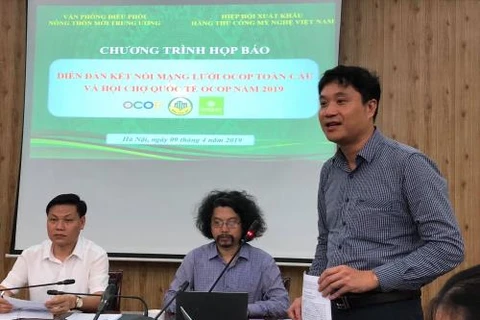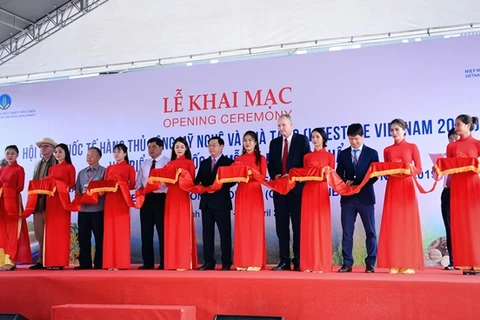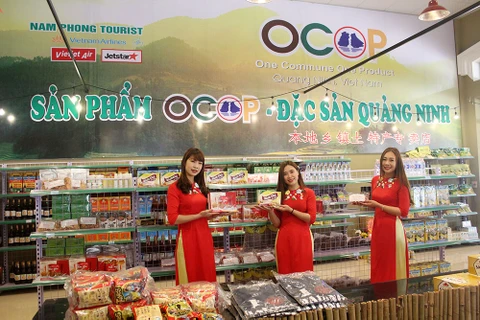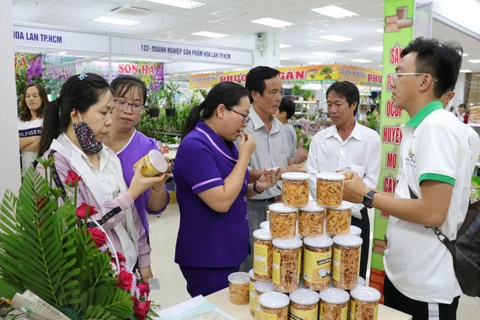Hanoi (VNA) – Hanoi has recently announced it will spend 265 billion VND (11.39 million USD) implementing the local One Commune-One Product (OCOP) programme for the 2019 – 2020 period.
According to the plan, 100 percent of OCOP programme managers at commune-, district, and municipal level public agencies as well as at organizations, businesses and cooperatives registering for the programme will have to undergo training to improve their building capacity.
Though implementing the initiative later than other localities nationwide, Hanoi is aiming to upgrade between 800 and 1,000 products to meet OCOP standards, of which 500 products are set to be ranked at municipal level and 100 others at national level.
The capital city has set a goal of developing at least two eco-craft village models. It will look to improve the local origin tracing system for agro-forestry-fishery goods (https://hn.check.net.vn) and website serving State management and demand-supply connectivity related to Hanoi’s OCOP products (http://nongthonmoihanoi.gov.vn/).
Initially, Hanoi’s OCOP programme will focus on a number of goods groups, including food, beverage, herbs, fabrics and apparel, souvenir – home decoration, and agricultural tourism.
Participating organisations will receive support to invest in machines and equipment for production; design and register their brand; obtain capital; hire experts, and distribute goods.
Currently, the city has approximately 7,200 products suitable to six OCOP groups. Of the total, there are 2,881 food products (39 percent); 2,417 souvenir – home decoration products (33.5 percent); and 1,396 fabric and apparel products (19.3 percent).
Hanoi holds great potential to make significant progress in implementing the OCOP programme. It has 157 large-scale fields and areas producing high-quality commercial rice, 157ha of fruit trees and over 80ha of tea meeting VietGap standards. The city also has 5,000ha for growing safe vegetables, including 352.7ha applying the VietGap standards and 40ha of organic vegetables.
The city has 76 key poultry breeding communes and 3,232 farms outside residential areas. It has 11 supply chains for safe vegetables and 21 supply chains for products from farm animals.
The OCOP was initiated by the Ministry of Agriculture and Rural Development in 2008, following the model of Japan’s “One Village, One Product” (OVOP) drive and Thailand’s “One Town, One Product” (OTOP). It is an economic development programme for rural areas focusing on increasing internal power and values, contributing to the implementation of the National Target Programme on New Rural Development for 2016-2020.
The classifications of goods and services defined in the programme include food (fresh and processed farm produce); beverages (alcoholic and non-alcoholic drinking); medicinal herbs (products made from herbal plants); fabric and textiles (products made from cotton and yarn); souvenirs, furniture, and decorations (products made from wood, fibres, rattan, metal, and ceramics); and rural tourism services and sales (services for sightseeing, tourism, study, and research).
The overall objective of the programme is to develop stable and sustainable forms of production for organisations and businesses (with priority given to developing cooperatives and small- and medium-sized enterprises), towards producing traditional products and improving services with high competitiveness on the domestic and international markets, thus promoting rural economy and national agriculture industrialisation and modernisation.
In 2013, Quang Ninh was the first province in Vietnam to pilot the programme. Concluding the first stage of the programme from 2013-2016, Quang Ninh developed 210 OCOP products. More than 180 economic establishments and households joined the programme.
As of late April this year, 60 out of 63 cities and provinces nationwide have built their OCOP frame programme at the provincial level, 30 of which have already completed the programme design and 28 others are collecting feedback before approval. Particularly, Quang Ninh province has entered the second phase.-VNA
VNA

























